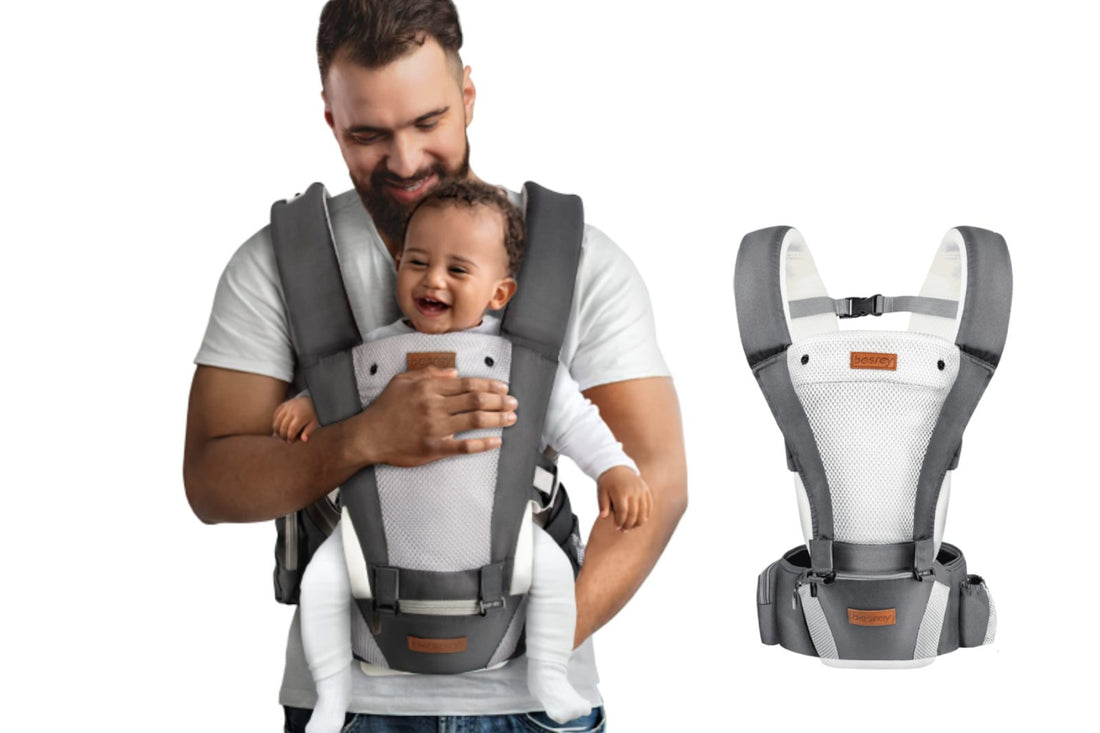
Can a Baby Carrier Cause Hip Dysplasia?
Going out with your baby is wonderful, but holding your baby for long periods can cause arm pain. The invention of baby carriers has made it easier for parents to take their children out. This product requires only a few simple steps to secure the baby to either mom or dad, freeing the parents' hands to do other things.
However, some concerns using a baby hip carrier to carry a newborn could result in Hip Dysplasia. Is this true? Today's article will go over every aspect of a baby carrier in detail to explain why it could or could not cause Hip Dysplasia.

What is Hip Dysplasia?
Hip dysplasia, also known as developmental dysplasia of the hip (DDH), can occur when a baby's hip joint does not develop properly.
The ball at the top of the thigh bone normally fits into the hip socket. Hip dysplasia occurs when the hip joint fails to develop normally, and the socket (also called the acetabulum) becomes too shallow.
The ball (also called the femoral head) can then slip partially or completely out of the joint. Hip dysplasia can range from a minor abnormality to complete hip dislocation. It is usually detected in babies.
Baby Carriers and Hip Dysplasia
Baby carriers are useful for short-term or sporadic parental activities. According to the International Hip Dysplasia Institute, short-term use of a baby carrier is unlikely to affect hip development.
In some cases, however, certain baby carriers and other devices, like wrong-sized baby carriers, slings, and wraps, may interfere with hip positioning. These devices, especially extended, can inadvertently place the hips in unhealthy positions.
Any device that confines an infant's leg in an unnatural position should be considered a potential risk factor for hip dysplasia.
In addition to other safety considerations, parents should select a baby carrier for proper hip positioning. Keep the hips apart, the thighs supported, and the hips bent when holding a baby, especially for long periods.
Baby Carriers That Can Cause Hip Dysplasia
The baby's hip is said to be in an unhealthy position when the legs are held straight in extension with the hips and knees stretched out and the legs brought together.
The longer the unhealthy positions are maintained, the more likely hip dysplasia will develop. Some devices, such as side slings or cradle slings, keep a baby's legs in straight positions, which increases the risk to the baby's hip, especially when used for a prolonged period.
A wrap can do the same to keep babies' legs wrongly straight, and carrying an incorrectly sized baby carrier leaves the legs dangling, increasing hip joint pressure.
Choosing the Best Baby Carrier to Avoid Hip Dysplasia
Suppose the baby carrier is properly sized and well-designed. In that case, it should comfortably secure the baby in a seated position with the legs and legs spread across the parent's body for a stable hip position.
Various names have been given to this position, such as the M-position, jockey position, straddle position, spread-squat position, and frog position.
When purchasing a baby carrier, you should pay attention to whether the carrier can provide good support for the baby's hips and thighs to form the M-position mentioned above.
Besrey has introduced its new, improved baby carrier with reinforced support to ease the worry about hip dysplasia.
This hip seat carrier features a versatile 2-piece system that offers eight comfortable babywearing positions from infant to toddler age — easily transitions from first snuggles to first steps.
Its 30-degree non-slip surface allows a baby's hips and knees to sit in a comfortable "M" position, promoting healthy hip and spine development.
Comes with a soft, supportive, and breathable mesh that covers the entire carrier, providing superior airflow.
Hence, both parents and baby stay cool and comfy, and a detachable baby hood provides a little darkness while napping or protection from the sun.
It redefines comfort by stretching and shaping to fit daddy and mommy for continual ergonomic support as your baby grows, with adjustable padded shoulder straps and an expanded waist belt.
It is lightweight and sturdy, with safety buckles and straps that hold the baby securely. All materials are free from harmful chemicals and conform to relevant global safety standards. Now, it's available in Besrey's store.

Factors to Consider when Choosing a Baby Carrier
When shopping for a baby carrier, keep the following factors in mind to help you find the best baby carrier for you.
Size: It is critical to select the appropriate size to accommodate your growing baby. A baby carrier that is too small may strangle your baby and cause discomfort, whereas a baby carrier that is too large may pose health risks by failing to secure your baby's hips.
Comfort: A good baby carrier should be comfortable for both the mother and the child. It should conform to the mother's body and not obstruct the mother's arm movement; it should also provide sufficient support for the baby's hips to avoid unhealthy hip positioning.
Quality: You should select a baby carrier that is of high quality. During use, inferior baby carriers will have issues such as the safety buckle falling off and the sewing thread falling off. Unqualified fabrics on inferior baby carriers can also harm your baby's skin.





